Home
Evening Walks
Wednesday 27 July 2005
and 2 August 2007, when the paths were more overgrown and signs had disappeared. Still a good walk though, and the Shady Oak has improved immeasurably.
|
Scary wildlife on this walk! |
 |
Beeston Castle circuit
Start at the Shady Oak for a 5 mile stroll.
Route Summary
1->2->3->4->1
A circuit from the Shady Oak around Beeston Castle
Take the A556 Chester road from Manchester, turning down the A49 at Sandiway. Continue down the A49 and at the far end of the Tarporley by-pass take the right turn down the A49. (Do not continue straight on down the A51 towards Nantwich.) Take the first turn on the right, after about ¾ mile, through Tiverton village, keeping on the lane towards Huxley (Huxley Lane) for about 2 miles, ignoring two turns to the right before turning left down a lane to Bate’s Mill Bridge and the Shady Oak, which was disappointingly devoid of character in 2005 (see report below). 45 minutes from south Manchester. [By 2007 the ambience of the Shady Oak had much improved.]

Instructions (see map below, and a laminated route card is available from Martin)
1 SJ 532 603 The Shady Oak near
Beeston
1->2 2.59km, 51 metres ascent, 40 mins
Leave the 150 year old pub and turn left over Bate's Mill bridge. The old
mill was a trout farm for a while and now has its own generator powered by
a water-wheel, visible below the road.
Look out for wildlife on this walk – common sightings listed below (note 1).
Continue over the railway and past some cottages before turning right down
a footpath through a field of crops. The path marked on the map enters the
field before the last cottage, but continue a further 50 metres or so along
the road to reach a proper path through the crops, reached through a narrow gap in the hedge. Go over the field, veering
slightly right towards an oak tree in the facing hedge, where a plank stile
crosses a deep ditch. Go ahead over the next field to stiles either side of
a grassy track, before heading for evergreen trees and another stile. Note
the differing styles and origins of Beeston
(note 2) and Peckforton
(note 3) castles looming ahead, whilst continuing alongside the trees. Pass
a pond, then another stile takes you to Lower Rock Farm and a chance to meet
some yappy dogs. Keep ahead to the sinisterly named road.
Go straight across along a path signed to Horsley Lane and Wickson Lane. following
a hawthorn hedge to the end of the field. Admire the healthy friesian cattle
or the tall crops of rape or sweetcorn. At the end of the next field cross
a stile and a plank bridge before turning left at an oak tree along a track
of grass and gravel signposted to Horsley Lane.
Leave this track at the first opportunity, bearing right over a stile and
continuing in line with the hedge to a stile at the far end of the field.
The next field ends in a stile between oaks in the facing hedge. Continue
straight on down a dirt track to the Elizabethan farmhouse at Moathouse Farm,
dwarfed by its huge brick chimney.
2 SJ 535 583 Moathouse Farm
2->3 1.24km, 15 metres
ascent, 20 mins
At Moathouse Farm ignore the Sandstone Trail signs (leave for another day!)
and turn left (east) down the lane and left again at the road. There's a pond
(perhaps the home of honking geese) to the right. Very soon a footpath leaves
the road and leads right into woods. Walk through the bracken on an indistinct
path near the left perimeter of the small wood, passing to the right of two
small ponds. After the second pond turn sharp left beside the pond along a
path that bears right at a farm and emerges at a road in Beeston.
3 SJ 543 585 Beeston
3->4 2.44km, 3 metres
ascent, 30 mins
After walking left along the road towards Beeston for just a few metres, turn
right over a somewhat overgrown stile down a path heading east. Note over
your left shoulder the clearly visible three tiers of castle walls, battlements
and gatehouse of Beeston Castle. Go straight across the next field if crops
or cows allow (the field was full of frisky but friendly fresians in July
2005), or make for a telegraph pole and stile to its right in the facing hedge.
Don't cross the stile but go left alongside the hedge. At a dog-leg bend bear
left, aiming for a house where a plank bridge and signpost lie to the right
of an ivy-shrouded oak tree. (There are two houses visible - you aim for the
one on the right.)
Turn right along the road then immediately right again towards Bunbury and
the A49. [The photos below were taken here.] Walk down the side of this long
field to a stile, which leads to a grassy track. Turn left to reach Deanbank
Cottages by the road. Cross the lane and continue in the same direction (north)
down the farm road (the left hand track) towards Beeston Hall Farm. Soon (before
the farm) turn right through a gate and then immediately over a stile down
an improbable looking path that drops down through a plantation of evergreens
to skirt a field. Cross a final meadow and climb a stile to reach Beeston
Cattle Market, with Beeston Castle Hotel to the right.
4 SJ 552 598 Beeston Castle Hotel
4->1 2.41km, 20 metres
ascent, 30 mins
Leave the pub or the market to the left along the A49, going under the railway
and over the (small) River Gowy before dropping down to the tow-path (note
4) on the left, heading west.
This is the Chester branch of the Shropshire Union Canal , built in 1775 as
a link between the Midlands and the Mersey ports. Look out for bats (note
5).
Note the rustic charms of Wharton's loch and bridge - the foundations of the
loch keeper's cottage - destroyed by a bomb in WW2 - can still be seen , together
with the remains of an old mill on the Gowy's banks. The Sandstone Trail is
again encountered here.
A gentle stroll on along the canal returns you to the Shady Oak for further
refreshments.
1 SJ 532 603 The Shady Oak
Total trip - 8.68km, 88 metres ascent, est'd time 2 hrs
The distance is the flat length to the next Waypoint. Timing is based roughly on Naismith's calculation of 5.00 Km/hour and 600 Metres ascent adds an hour.

Bibliography:
Wildlife Walks in Cheshire and the Wirral – Tony Bowerman – Thistle Books
1991
Circular Walks on the Sandstone Trail – Ruth Rogers – Mara Publications 1994
Pub Walks in Cheshire – Real Ale Rambles – Jen Darling – Sigma Leisure 1990
Some notes that may be of interest:
1. Commonly seen wildlife:
Fauna: rabbits, badgers, glow-worms (esp on the railway ballast
late at night), bats, kestrels, kingfishers, water rail, mallard, wrens, whitethroats,
chiffchaffs, garden- willow- and sedge warblers, grass snakes, swallows, house
martins, little owls, water voles, grey squirrels, woodpeckers (3 species),
long-tailed tits, wagtails, snipe, jackdaws, stock doves, barn owls, yellowhammer,
sand martins, lots of butterflies and grasshoppers, moorhens, and many more.
Flora: Creamy meadowsweet, purple tufted vetch, meadow and
creeping buttercups, red clover, bindweed, St John’s wort, rosebay and great
willowherbs, butterbur, monkey flowers, fleabane, lady’s bedstraw, ox-eye
daisies, yarrow, crows foot, watercress, water forgetmenot, dog rose, ivy-leaved
toadflax, cowslips, primroses, and many more.
2. Beeston
Castle dates from around 1220 and was built by Randle de Blunderville,
6th Earl of Chester. It passed in and out of royal ownership before being
abandoned in the 16th century. In the following century however, enough of
the defences remained to give cover to a band of Parliamentarians for over
9 months. In December of 1645 Royalist troops ousted them before fleeing after
the Battle of Rowton Moor, near Chester. Parliament then ordered the partial
destruction of the defences and the castle has been little more than a ruin
ever since. There is a legend that Richard 11 hid treasure in the 400-foot
deep well in the upper keep during the 14th century, though this has never
been found.
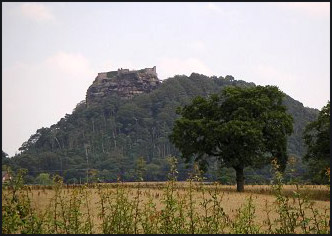
3. Peckforton
Castle was built between 1844 and 1851 for the first Lord Tollemache
by Anthony Salvin, the Victorian architect. It was designed in the style of
a Norman Fortress, common enough at the time but unlike elsewhere, Peckforton
is not just a façade of turrets and battlements. It has inner and outer
wards with gatehouses and a great hall open to the roof. This lends it to
be the setting for film and TV productions such as a 1991 Robin Hood film.
4. The canal may look muddy, but it is deceptively clean,
as evidenced by large freshwater mussels – to the delight of the local herons
and herring gulls. There are also fish, mainly roach and bream but also some
large carp, and numerous eels that prefer the deeper water by the lochs. Until
the1950s eels were caught at nearby Bunbury lochs for sale in London.
5. As dusk falls the bats come out to play. On this walk
you may see (in descending order of likelihood) pipistrelle, noctule, long-eared
or water bats.
On the evening of 27 July 2005 a little group comprising Martin, Sue, Richard, Jenny, Mike, Andrew, Anne and Richard P from Perth, Australia, enjoyed a pleasant stroll around this route, starting at 7.40 and finishing at dusk at 9.40pm.
We didn't see any glow-worms, but at one point just after the photos below were taken, Andrew was surprised by a large badger crashing through his legs. Some medium-sized birds of prey were seen but not identified, and a heron escorted us down the last section along the canal after the sun had become a glowing red ball and set at 9pm, and before the band of rain that had been travelling north all day finally reached us.
We didn't dally to look for interesting flora - pink flowered rosebay and great willowherbs were dominant, with fleabanes and ragworts providing occasional slashes of yellow against the fading ochres of the rapeseed and other crops in the fading light of the summer evening.
The final stretch of this surprisingly varied walk, circumnavigating the towering lump on which the remains of Beeston Castle linger, was along a pretty canal where families of sleepy mallards curiously enquired as to whether we could provide them with a few crumbs for supper. Towards the end we passed numerous canal boats in which the occupants were cooking, watching TV, washing up, playing cards, etc. We wondered why they weren't in the Shady Oak and we soon discovered the reason. The lounge of the once welcoming hostelry had a large TV screen onto which was projected the constant blast of a dance music channel. A few canal boaters, desperate for a drink, were cowering with some ale in one corner, and the only other occupants seemed to be some customers who were ineptly trying to serve drinks. The beer barrel was empty and when the landlord returned from 'walkabout' he declined to change it. That said, we enjoyed a convivial 45 minutes in the pub - it will surely return to better times - before heading home from this relaxing mid-week break (the last one for Richard P, who soon returns home to Perth).
All in, a very pleasant final walk in our short season of summer evening travails in the UK.
 |
 |
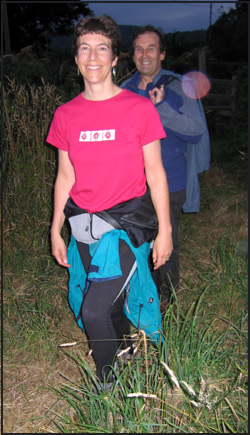 |
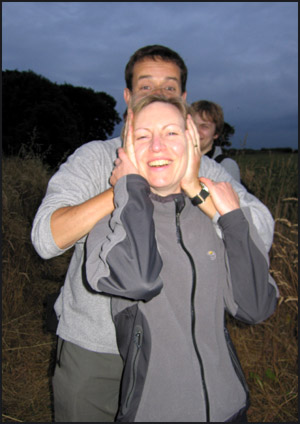 |
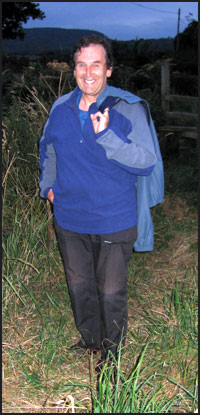 |
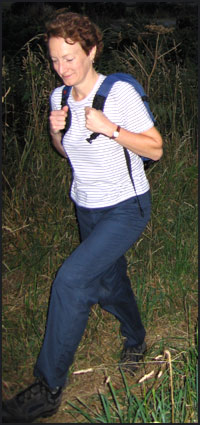 |